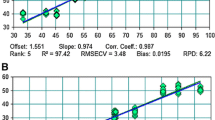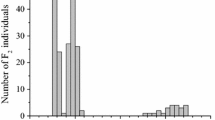Abstract
Safflower (Carthamus tinctorius L.) oil with high oleic acid content (>75%) has a great value for both food and non-food uses. The trait has been reported to be environmentally stable and controlled by recessive alleles at one single gene Ol, even though the influence of modifying genes has been suggested. Additionally, germplasm with higher oleic acid content (>85%) has been reported. The objective of the present research was to study the inheritance of high oleic acid content in genetic sources with both levels of high oleic acid content (>75 and >85%, respectively). A genetic study was conducted by crossing the nuclear male-sterile line CL1 (18% oleic acid) and the high oleic acid lines CR-6 (80%) and CR-9 (87%). The evaluation of the F1 and F2 seed generations of the crosses CL1 × CR-6 and CL1 × CR-9 indicated that in both cases the high oleic acid trait was controlled by partially recessive alleles at a single locus. The observation of F2, F3, and F4 segregants with high oleic acid phenotype but lower oleic acid levels than the parents revealed the presence of modifying genes affecting the trait. Crosses between the two high oleic acid lines produced no transgressive segregation other than that caused by the mentioned modifying genes, suggesting that the high oleic acid lines CR-6 and CR-9 share the same alleles at the Ol locus. Differences for oleic acid content between both lines were hypothesized to be produced by the accumulation of genes with a minor effect on the trait.








Similar content being viewed by others
References
Bergman JW, Riveland NR, Flynn CR, Carlson GR, Wichman DM, Kephart KD (2006) Registration of ‘Montola 2004’ safflower. Crop Sci 46:1818–1819. doi:10.2135/cropsci2005.12-0494
Briggs FD, Knowles PF (1967) Introduction to plant breeding. Reinhold Publishing Corporation, New York
Corbett P (2002) Research in the area of high oleic oils. Bulletin IBP, Number 1, 2002. Institut de Biotechnologie des Plantes, CNR-NRC, Canada. http://www.pbi.nrc.ca/fr/bulletin/2002issue1/page3.htm. Accessed 30 June 2008
Fernández-Martínez JM, Jiménez A, Domínguez J, García JM, Garcés R, Mancha M (1989) Genetic analysis of the high oleic content in cultivated sunflower (Helianthus annuus L.). Euphytica 41:39–51. doi:10.1007/BF00022409
Fernández-Martínez J, del Rio M, de Haro A (1993) Survey of safflower (Carthamus tinctorius L.) germplasm for variants in fatty acid composition and other seed characters. Euphytica 69:115–122. doi:10.1007/BF00021734
Fernández-Martínez JM, Velasco L, Pérez-Vich B (2004) Progress in the genetic modification of sunflower oil quality. In: Proceedings of 16th international sunflower conference, Fargo, ND, USA, 29 August–2 September 2004, pp 1–14
Fernández-Martínez JM, Pérez-Vich B, Velasco L, Domínguez J (2007) Breeding for specialty oil types in sunflower. Helia 46:75–84
Garcés R, Mancha M (1993) One-step lipid extraction and fatty acid methyl esters preparation from fresh plant tissues. Anal Biochem 211:139–143. doi:10.1006/abio.1993.1244
Heaton TC, Knowles PF (1980) Registration of UC-148 and UC-149 male-sterile safflower germplasm. Crop Sci 20:554
Heaton TC, Knowles PF (1982) Inheritance of male sterility in safflower. Crop Sci 22:520–522
Horowitz B, Winter W (1957) A new safflower oil with low iodine value. Nature 179:582–583. doi:10.1038/179582a0
Knowles PF (1972) The plant geneticist’s contribution towards changing lipid and amino acid composition of safflower. J Am Oil Chem Soc 49:27–29. doi:10.1007/BF02545133
Knowles PF (1989) Safflower. In: Downey RK, Röbbelen G, Ashri A (eds) Oil crops of the world. McGraw-Hill, New York, pp 363–374
Knowles PF, Hill AB (1964) Inheritance of fatty acid content in the seed oil of a safflower introduction from Iran. Crop Sci 4:406–409
Knowles PF, Mutwakil A (1963) Inheritance of low iodine value of safflower selections from India. Econ Bot 17:139–145
Lacombe S, Kaan F, Léger L, Bervillé A (2001) An oleate desaturase and a suppressor loci direct high oleic acid content of sunflower (Helianthus annuus L.) oil in the pervenets mutant. CR Acad Sci Paris Life Sci 324:839–845
Mensink RP, Katan MB (1989) Effect of a diet enriched with monounsaturated or polyunsaturated fatty acids on levels of low-density and high-density lipoprotein cholesterol in healthy women and men. N Engl J Med 321:436–441
Pérez-Vich B, Fernández-Martínez JM, Grondona M, Knapp SJ, Berry ST (2002) Stearoyl-ACP and oleoyl-PC desaturase genes cosegregate with quantitative trait loci underlying stearic and oleic acid mutant phenotypes in sunflower. Theor Appl Genet 104:338–349. doi:10.1007/s001220100712
Urie AL (1985) Inheritance of high oleic acid in sunflower. Crop Sci 25:986–989
Urie AL, Peterson WF, Knowles PF (1979) Registration of oleic leed safflower. Crop Sci 19:747
Velasco L, Pérez-Vich B, Fernández-Martínez JM (2000) Inheritance of oleic acid content under controlled environment. In: Proceedings of 15th international sunflower conference, Toulouse, France, 12–15 June 2000, vol I, pp A31-A36
Yodice R (1990) Nutritional and stability characteristics of high oleic sunflower seed oil. Fat Sci Technol 92:121–126
Acknowledgments
The authors thank the USDA-ARS Western Regional Plant Introduction Station for providing germplasm accessions, as well as Angustias Jiménez and Alberto Merino for technical assistance. Y.A.S. Hamdan was the recipient of a grant from the Agencia Española de Cooperación Internacional (AECI).
Author information
Authors and Affiliations
Corresponding author
Rights and permissions
About this article
Cite this article
Hamdan, Y.A.S., Pérez-Vich, B., Velasco, L. et al. Inheritance of high oleic acid content in safflower. Euphytica 168, 61–69 (2009). https://doi.org/10.1007/s10681-008-9879-y
Received:
Accepted:
Published:
Issue Date:
DOI: https://doi.org/10.1007/s10681-008-9879-y




